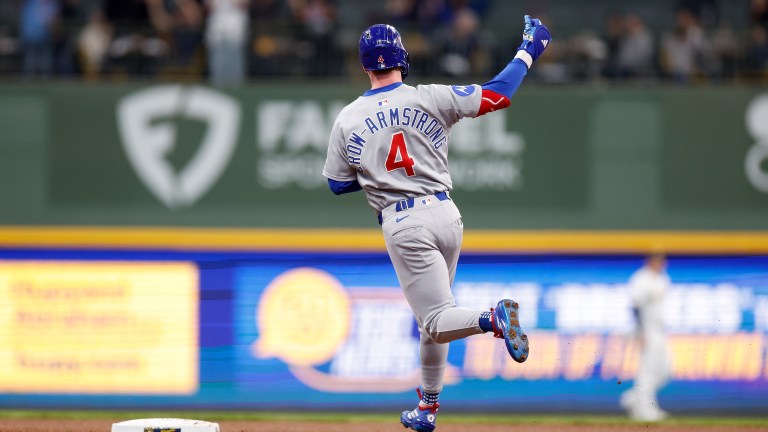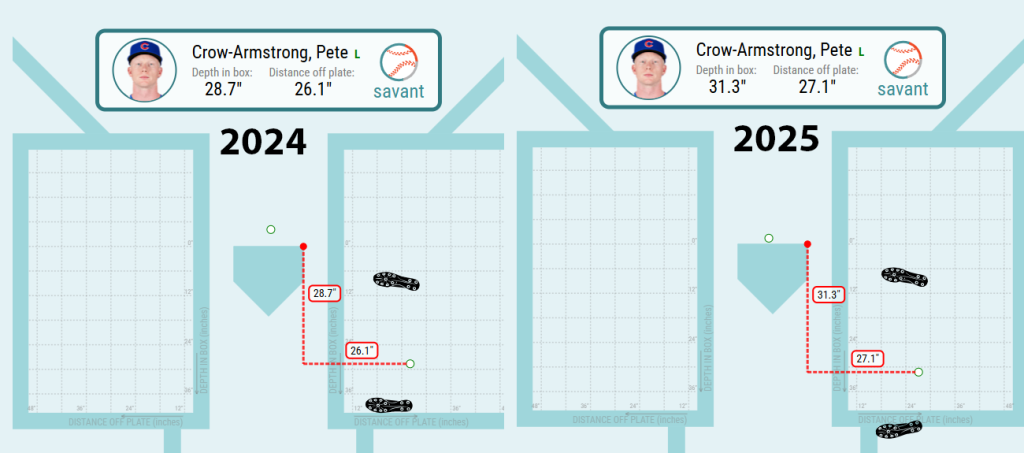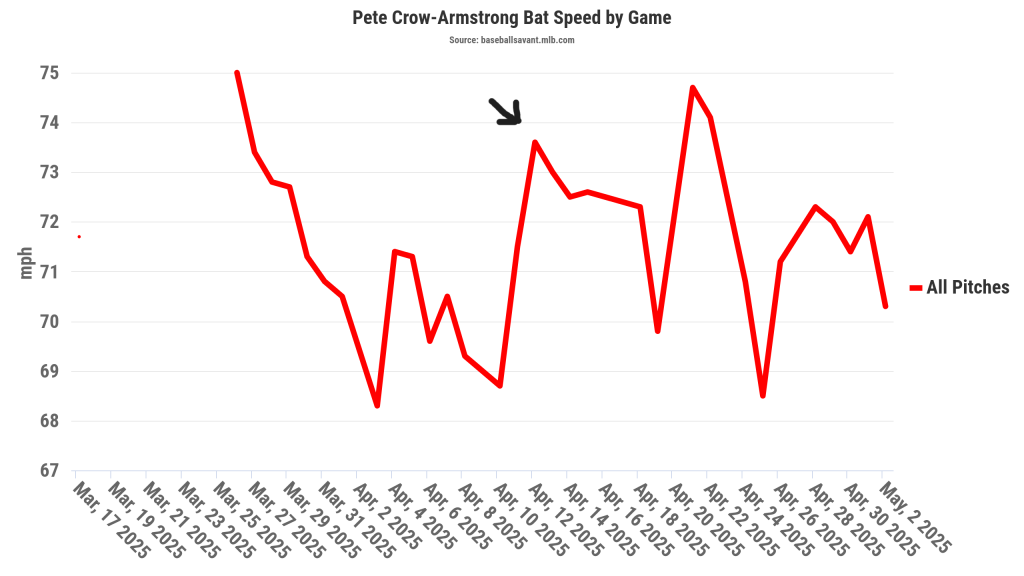What’s Behind Pete Crow-Armstrong’s Newfound Power?
How has Pete-Crow Armstrong gone from below average bat to MVP candidate? Let's look at the adjustments that led to a PCA breakout.

Pete Crow-Armstrong entered 2025 an offensive profile away from becoming an elite player. The then 22-year-old outfielder showed flashes of success during parts of the 2024 season, but needed to increase his 87 wRC+. Those improvements are coming in a big way this season.
Entering play on Tuesday, Crow-Armstrong owns a .271/.306/.550 slash line for a 137 wRC+ in his first 150 plate appearances of the season. His outstanding 2.4 BsR and 6.5 Defensive Runs Above Average have molded him into a top-six player in the league, according to Fangraphs calculation of WAR. This production has helped aid the Chicago Cubs to an NL Central leading 22-14 record.
With Crow-Armstrong’s elite combination of defense and baserunning, his offensive production in the early goings of this season is far beyond what was necessary for PCA to become an All-Star caliber player. Instead, he has transformed into an MVP candidate at age 23. His nine home runs in just 36 games this year have him on pace to nearly double the 10 he hit in 146 games between 2023 and 2024.
Although a 137 wRC+ is hard for anyone to sustain, especially with a .279 ISO, PCA made adjustments the season that explain the sudden jump in power. These changes could help the Cubs centerfielder remain an offensive threat throughout the season.
Find a new stance

Crow-Armstrong made crucial changes to his batting stance between this year and last. He moved about 2.5 inches back in the box, and widened the gap between his feet by about seven inches. In 2024, he posted a 24.5% strikeout rate between 2023 and 2024, and needed to work on his timing. These seemingly minute changes gives PCA an extra split-second to get the bat on he ball, but they’ve made major differences.
Going into this year, it felt like any power numbers coming from PCA would be a bonus to ideally high contact numbers, along with his stellar play in centerfield and his elusiveness on the basepaths. It turns out giving yourself more time to see the ball and allowing for a more controlled leg kick increases bat speed and improves timing.

Between this year and last, Crow-Armstrong has increased his average bat speed from 70.6 mph to 71.6 mph. He is one of 31 qualifying hitters to increase the average speed of their swing by a full mile-per-hour. Much of that change started on April 13 the date with an arrow seen above it on the listed chart. This is when PCA began consistently swinging the bat faster than his previous average. From March 17 through April 12, his average bat speed was 71.2 mph. Since then, it’s increased to 71.9 mph.
It’s no coincidence that April 13 is also the day PCA began is torrid run that has molded him into one of the game’s great hitters of this year. Heading into that Sunday Night Baseball game at Dodger Stadium, Crow-Armstrong had suffered a .521 OPS in his first 17 games of the season. One triple and two home runs later, everything changed.
This home run, PCA’s first of the season, registered an 82 mph swing, his fastest of the year to that point. That swing started the run he remains on to this day. Since April 13, he is slashing .338/.347/.811/1.157 in 77 plate appearances. His 218 wRC+ rank second among qualifiers trailing only Aaron Judge, and his .811 SLG leads the 176 qualifiers.
Pull side Pete
Not only does standing back in the box and increasing bat speed enable a power surge for any hitter, it also helps to better time a ball up, something that has been crucial for Crow-Armstrong’s growth.
In 2024, PCA posted a 29.8% fly ball rate, six percent above the Major League average. Despite this, his .463 slugging percentage on fly balls was over 300 points below the .788 leaguewide mark. It’s not like he wasn’t hitting his fly balls hard enough for them to get out. His 20% barrel rate on fly balls was only 2.5% below the Major League average. His problem was his distribution of power.
Only 24.7% of fly balls hit by PCA in 2024 were hit to the pull side, below the league average of 27%. More notably, his 19% barrel rate on these fly balls to right field was well below the 36.3% league average on pulled fly balls. This resulted in Crow-Armstrong hitting an abundance of lazy fly balls to right. Throughout Major League Baseball, fly balls hit to the pull side have a 30% higher chance of being converted to home runs compared to those hit straightaway or to the opposite field. PCA would need to start pulling more fly balls and hitting them harder to see any consistent power.
| PCA By year | Fly Ball % | Pull % on Fly Balls | Barrel % on Fly Balls | Home Run / Fly Ball % |
| 2023 | 33.3% | 0.0% | 33.3% | 0.0% |
| 2024 | 29.8% | 24.7% | 20.0% | 9.4% |
| 2025 | 35.7% | 38.4% | 30.0% | 22.5% |
A 15.3% increase in pull rate on fly balls and 10% increase in barrel rate on fly balls has led to a 13.1% increase in home run to fly ball rate. PCA’s 40% pull rate on his fly balls ranks tied for the 13th highest among the 82 hitters with at least 25 fly balls in 2025. These numbers have put Crow-Armstrong on a 42 home run pace through the season’s first six weeks.
More hits, less whiffs
This newfound better timing has not only enhanced PCA’s batted ball profile, it has been a gateway to more contact. Crow-Armstrong has lowered his strikeout rate from 24.5% before 2025 to 20.7% this year. More impressively, his Whiff rate has seen an eight percent decrease from 30.5% to 22.3% in this span. Most of these changes have come against breaking balls and offspeed pitches.
Throughout PCAs first two big league seasons, he posted a 33.3% Whiff rate against sliders, changeups, curveballs, and other breaking balls and offspeed pitches. He hit .213 and slugged .390 against them. Naturally, opponents have pitched to him with this in mind in 2025. This year, Crow-Armstrong has seen nearly six percent more of these pitches compared to last year, but he was prepared for these changes.
In 2025, Crow-Armstrong has whiffed at only 20.9% of all breaking balls and offspeed pitches. He is hitting .282 and slugging .474 against them so far this year. Once a reliable way to get him out, these improvements have made PCA harder to pitch to, and have aided his early breakout.
Crow-Armstrong already had a lot on his side coming into this year. His excellent defense/baserunning combinations were a dependable reason for the Cubs to justify trading Cody Bellinger to make him a full-time player this year. He just needed to be a playable enough bat to back this up. Not only has he done that, but he’s made adjustments helping him become one of the best bats in a loaded Cubs lineup. The 23-year-old still has a lot of season left to prove himself, but what we’ve seen so far is beyond the ideal start to his 2025 campaign.
*All stats updated prior to play on 5/6*
